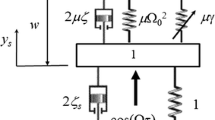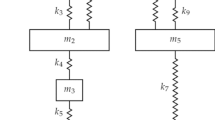Abstract
Tuned mass dampers are useful devices for limiting vibrations in various machines. Their main advantage is that they can be used as add-on elements and do not require integration into the main structure. However, conventional tuned mass dampers that use viscous or material damping are not attractive from the energetic point of view because they also dissipate energy in the case of unobjectionable small vibrations. Dry friction used as a lock-up element for the tuned mass damper could aid in overcoming this disadvantage. The dynamics of such a system are investigated in this paper. A special analytic technique based on variables’ rescaling is applied to obtain approximate analytical predictions of the steady-state amplitudes for both the main system and the mass damper. The results show that the lock-up mass damper can efficiently limit the amplitudes at resonance for a wide range of parameters but cannot supply perfect vibration suppression at any tuned frequency. Additionally, the efficiency of the system is limited to a certain excitation range. Excitation that increases over a certain threshold leads to notably high vibration amplitudes that cannot be handled by the described simple approach. All analytical results are confirmed by numerical simulations of the full system.



Similar content being viewed by others
References
Alspaugh, A.: Analysis of Coulomb friction vibration dampers. J. Sound Vib. 57(1), 65–78 (1978)
Feeny, B., Guran, A., Hinrichs, N., Popp, K.: A historical review on dry friction and stick-slip phenomena. Appl. Mech. Rev. 51(5), 321–341 (1998)
Ferri, A.: Friction damping and isolation systems. Trans. ASME J. Vib. Acoust. 117B, 196–206 (1995)
Popp, K., Panning, L., Sextro, W.: Vibration damping by friction forces: theory and applications. J. Vib. Control 9(3–4), 419–448 (2003)
Den Hartog, J.: Forced vibrations with combined Coulomb and viscous friction. Trans. ASME 53, 107–115 (1931). APM-53-9
Shaw, S.: On the dynamic response of a system with dry friction. J. Sound Vib. 108(2), 305–325 (1986)
Ruzicka, J.E., Derby, T.F.: Influence of Damping in Vibration Isolation. No. SVM-7. Shock and Vibration Information Center (Defense), Washington DC (1971)
Gaul, L., Lenz, J.: Nonlinear dynamics of structures assembled by bolted joints. Acta Mech. 125(1–4), 169–181 (1997)
Gaul, L., Nitsche, R.: The role of friction in mechanical joints. ASME. Appl. Mech. Rev. 54(2), 93–106 (2001)
Kruse, S., Tiedemann, M., Zeumer, B., Reuss, P., Hetzler, H., Hoffmann, N.: The influence of joints on friction induced vibration in brake squeal. J. Sound Vib. 340, 239–252 (2015)
Panovko, Y.G., Gubanova, I.I.: Stability and Oscillations of Elastic Systems; Paradoxes, Fallacies and New Concepts. Consultants Bureau, New York (1965)
Fidlin, A., Lobos, M.: On the limiting of vibrations amplitudes by a sequential friction-spring element. J. Sound Vib. 333, 5970–5979 (2014)
Bhaskararao, A., Jangid, R.: Harmonic response of adjacent structures connected with a friction damper. J. Sound Vib. 292(1–3), 710–725 (2005)
Hetzler, H.: On the effect of nonsmooth Coulomb damping on flutter-type self-excitation in a non-gyroscopic circulatory 2-DOF-system. Nonlinear Dyn. 73(3), 1829–1847 (2013)
Fidlin, A.: On the dynamics of a lock-up mass damper. In: 88th Annual Meeting of the International Association of Applied Mathematics and Mechanics, March 6–10, 2017, Weimar, Germany, Book of Abstracts.https://www.tu-ilmenau.de/fileadmin/media/analysis/trunk/170304_BoA_GAMM_2017.pdf
Aramendiz, J., Fidlin, A.: Analysis of a lock-up mass damper via averaging methods of second order. In: 89th Annual Meeting of the International Association of Applied Mathematics and Mechanics, March 19–23, 2018, Munich, Germany, Book of Abstracts. http://jahrestagung.gamm-ev.de/images/2018/book_of_abstracts.pdf
Sanders, J.A., Verhulst, F.: Averaging Methods in Nonlinear Dynamical Systems. Springer, New York (1985)
Fidlin, A.: Nonlinear Oscillations in Mechanical Engineering. Springer, Berlin (2006)
Acknowledgements
This work was supported by the DFG German Research Foundation Grant FI 1761/2-1 within the Priority Program SPP 1897 “Calm, Smooth and Smart—Novel Approaches for Influencing Vibrations by Means of Deliberately Introduced Dissipation.”
Author information
Authors and Affiliations
Corresponding author
Ethics declarations
Conflict of interest
The authors declare that they have no conflict of interests.
Appendix A: Formal averaging procedure
Appendix A: Formal averaging procedure
Equations (13) and (14) can be written in the following compact form:
It is useful for further analysis to convert to \(\psi \) as the independent variable:
Retaining the terms of \(O\left( {\varepsilon ^{2}} \right) \), the following equation can be obtained:
Second-order averaging means applying the following nearly identical variable transformation:

It is common within the averaging procedure to require that the new variables \(\xi \) fulfill the following autonomous equations (functions \(\varXi \) must be determined within the procedure later):
Substituting (A.4) into Eq. (A.3), applying Taylor series expansion, considering (A.5) and balancing terms with the same powers of \(\varepsilon \) leads to the following equations:
The function \(u_1 \left( {\xi ,\tilde{\bar{{A}}},\psi } \right) \) must be limited in the fast variable \(\psi \). This requirement enables us to determine the function \(\varXi _1 \):
In this work, \(\left\langle \ldots \right\rangle _\psi \) means periodic averaging with respect to the variable \(\psi \). Note that the scaling of the variable A according to (8) is also valid for the corresponding u-terms:
The function \(\varXi _2 \) is determined similarly from Eq. (A.7) combined with the requirement that the function \(u_2 \) must be limited in \(\psi \):
It is not necessary to calculate \(u_2 \) explicitly if the analysis is limited to the second-order approximation.
Substituting expressions (A.8) and (A.10) into Eq. (A.5) and setting the right-hand side to zero give the algebraic equations that determine the steady-state solutions of the averaged equations:
These equations have been solved in an asymptotic manner by balancing the terms with the same powers of \(\varepsilon \). This approach delivers the following two sets of four algebraic equations each, thus determining the required approximations:
The first set leads directly to the stationary solutions (15). The second set delivers the solutions used to calculate the black solid lines in Fig. 2.
Rights and permissions
About this article
Cite this article
Fidlin, A., Aramendiz, J. Study on the dynamics of a lock-up mass damper: asymptotic analysis and application limits. Nonlinear Dyn 97, 1867–1875 (2019). https://doi.org/10.1007/s11071-018-4662-7
Received:
Accepted:
Published:
Issue Date:
DOI: https://doi.org/10.1007/s11071-018-4662-7




